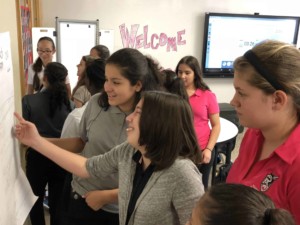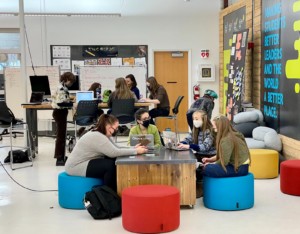The Implications of Gartner’s Top 10 Tech Trends of 2018 for Education

This post is part one of a two-part overview. For the second entry, click here.
By Jim Goodell, Liz Glowa and Brandt Redd
In October, Gartner released a report with predictions about the top tech trends for business in 2018. Gartner uses the term the intelligent digital mesh to describe “the entwining of people, devices, content and services” that will create the “foundation for the next generation of digital business models and ecosystems.” These trends are classified within three categories.
- Intelligent: How AI is seeping into virtually every technology and with a defined, well-scoped focus can allow more dynamic, flexible and potentially autonomous systems.
- Digital: Blending the virtual and real worlds to create an immersive digitally enhanced and connected environment.
- Mesh: The connections between an expanding set of people, business, devices, content and services to deliver digital outcomes.
What are the implications of these trends for education?
Education often falls behind the business world in realizing the potential of new technologies. There are however a few bright spots where the timing might be right for the tech trends in the business world to have a positive impact in education sooner rather than later.
The top 10 trends according to Gartner are analyzed below for their implications for education:
Intelligent: AI Foundation, Intelligent Apps and Analytics, Intelligent Things
1) Artificial Intelligence Foundation
Artificial intelligence (the ability of machines to display “cognitive” functions like learning or problem solving) already impacts a lot of things we do outside of education. This is the technology working behind the scenes to “learn” from patterns in the data and inform improvement as evidenced in such areas such as self-driving cars, facial recognition, fluent verbal language translation, and computers that can beat world champion humans at games like chess and Go. The use of AI in K12 and higher ed could grow 47.5 percent by 2021, according to a recent survey by Research and Markets, “Artificial Intelligence Market in the US Education Sector 2017-2021.”
“Code that learns will prove to be humankind’s greatest invention—and, some worry, its demise. Artificial Intelligence (AI) will have more influence on the lives and livelihoods of young people over the next several decades than any other factor.” — Tom Vander Ark, Ask About AI: The Future of Work and Learning
One future potential of AI is as a guide to educators and students to optimize the work of teaching and learning. Among the best uses of AI is to inform real intelligence. The student is a “real intelligence” in a student-facing learning system and should have voice and choice in their learning. For example, rather than having a recommendation engine which uses AI prescribe a single digital resource to use, it may be better to recommend a limited number of options based on data about the student and the effectiveness of the resource and let the student make the decision. The process of interpreting the recommendations presented by the AI and choosing an activity may be as important to learning as the activity itself.
We see the potential for new AI guided learner experiences that take advantage of what we know from the learning sciences about how people learn to help learners own and optimize their own learning. For example, we see digital resources offering options based on learner preferences about how to learn something. An AI-supported process of “guided metacognition” could help learners describe their thinking while learning something, to try another learning method, and compare which method is most effective. When talking about AI in education people often jump directly to non-human scoring of essays and mathematical expressions, which is still evolving. In the short term, AI may be more effective in other areas such as recommending learning resources, making materials accessible to students with disabilities, or classifying reading materials in terms of text complexity. AI also has near-term potential to make a difference in optimizing personalized learning experiences through adaptive skill building and providing formative feedback.
AI can enhance the work of educators to focus effort on the things that matter most and the things that machines can’t do.
“In preparing students for the future, we should think less about AI and more about IA, or intelligence amplification: The idea that digital devices complement our human strengths to enable accomplishments beyond what either machines or people can do alone.” — Chris Dede, What will the job market look like in 2030?
AI can support teachers by serving as a guide to teachers to help inform practice, to manage the complexity of new student-centered and project-based models of teaching and learning, and to better inform day-to-day decision-making.
We expect the impact of AI in mainstream education will grow due to three other areas of growth:
- The use of “big data” and data interoperability,
- The increased use of digital resources and blended learning modalities, and
- Education games.
In other industries, AI has been fed by “big data”. The “machine learning” algorithms used by Apple, Amazon, and Google learn from patterns found in huge volumes of data to predict what you might want to buy to recommend products or target advertising. Education data held hostage in siloed systems has kept educators and student from critical information about their own classroom practices and learning and from the kind of insights that AI could provide when given a complete record of student learning. These silos are being broken down.
Interoperability is the ability of separate software applications to work together and share data. Local education agencies and vendors are realizing that data “held hostage” in one system or another is limiting educator’s ability to best meet student needs. Vendors are also realizing that failed strategies of the past, holding data hostage or trying to control the market as “the app store for education,” has not worked. Interoperability now drives market value. Apps content and platforms that fail to interoperate will lose ground in the market. Initiatives like Project Unicorn (www.projunicorn.org) are accelerating push toward interoperability.
Increased use of digital resources provides richer data sets from which to inform decision making. This is especially true when the resources are interactive and the learner’s use of the resource is part of a coherent model that connects it to other learning experiences, such as with blended learning. Blended learning is when a student learns, at least in part, at a supervised brick-and-mortar location away from home and, at least in part, through online delivery with some element of student control over time, place, path, and/or pace. The online student-centered part of blended includes data about learning experiences that AI technology can use for just-in-time recommendations and formative feedback for educators and students. The growth of blended and online learning puts data to work in ways that previously didn’t exist and will let more students benefit from what AI technology has to offer.
A recent report, Artificial Intelligence Market in the US Education Sector 2017-2021, notes that “One trend in the market is artificial intelligence-empowered educational games. Educational games provide teachers a useful medium to teach education concepts in an interactive and engaging manner. Such a method not only generates curiosity but also motivates through reward points, badges, and levels (gaming features). Vendors are incorporating features of artificial intelligence in games to enhance the interactivity element. These games embody the adaptive learning feature so that students can be given frequent and timely suggestions for a guided learning experience. These games improvise adaptive learning features while deploying machine learning, a form of artificial intelligence.”
2) Intelligent Apps and Analytics
“Over the next few years every app, application and service will incorporate AI at some level. AI will run unobtrusively in the background of many familiar application categories while giving rise to entirely new ones.” –Gartner
Intelligent apps are the human-interface to the AI. The big idea here is that the human experience and productivity are improved when informed by AI. It is not just AI–it is AI interacting with human intelligence, preferences, and dispositions, including motivational dispositions.
Similar to business, the use of AI in education will increase and the most successful uses of AI will target specific content and contexts. For example, the DuoLingo app is optimized for language learning and EquatIO is optimized for mathematical formulas. Game-based learning and simulations improve on engagement over current modalities of online learning in part because of the level of feedback they provide. AI can enhance the quality and effectiveness of that feedback.
Recommendation engines, such as those that run behind commercial platforms like Amazon and Netflix, narrow the list of choices for a person to make rather than make the choice for them. AI can help by “noticing” patterns in large data sets and helping students and educators use that information as a guide toward more effective practices. Recommendation engines for education have had limited success in part because the interface for the big data in education (the learning experience) is much more complex than the interface for online shopping.
However, learning analytics in education are coming more and more to the forefront. “Learning analytics is the education industry’s response to ‘big data’ that is used in the business world for improvements and redirection of focus.” Improvements in app interoperability and in standard ways of capturing and making sense of the learning experience data are opening the door to new kinds of learning experiences through the use of learning analytics. For example, learning analytics can be used to show students what they have achieved and inform them about the efficiencies of the decisions they make while learning, so they can make the learning more efficient the next time around. AI powered applications could warn teachers early of academic issues and provide more intelligent, consumable data on student progress.
3) Intelligent Things
Things connected to the internet increasingly have access to AI. Everything from smart phones and cameras, to robotic vacuum cleaners, to refrigerators that remind you by text message to buy milk, to home security systems are using AI and internet connectivity. In education, innovation has been enabled through a growing collection of internet-connected technologies and devices – such as interactive whiteboards, ebooks, digital highlighters and pens, attendance tracking systems, connected school buses, smart lighting and security cameras – which provide real-time data and valuable insights to students, parents, teachers and administration.
Intelligent things in education could also include things like mathematics manipulatives that not only provide the visual and tactile representation of abstract concepts, but also monitor learner interactions and provide real-time feedback to scaffold the learning. Intelligent lab equipment that self-monitors use and collects data to check student’s work, offer hints to the student and give feedback to the student and teacher could be used to assist instruction. Assistive devices embedded with AI could have enormous value for students. For example, software has been developed that does lip reading better than humans. A device incorporating this AI combined with voice recognition could translate to text the spoken words of a teacher even in a noisy environment and make these available to students in near real time. The field is actively exploring innovative uses of intelligent things.
Unintelligent things can also be valuable learning tools. Turtle robots have been used for more than 30 years as a tool to teach computational thinking and problem-solving. These kinds of robots get their “intelligence” from the programming that the students do, and what makes it a valuable learning tool is that the student needs to do the thinking. However, such tools could be enhanced by an intelligent agent that is self-aware and gives formative and motivational feedback to help the students work through failed attempts toward a working solution.
Schools and districts are already using the power of the Internet of Things (IoT) to keep track of people, assets and activities. “With the aid of the IoT, a variety of options are possible in terms of environmental and energy conservation, ecosystem regulation, traffic, and transport, to name a few, that can help schools build up their budgets and offer better learning opportunities.”
With the increase in the use of intelligent things, privacy and security considerations need to kept at the forefront of implementation efforts.
For the remaining seven implications of Gartner’s top 10 tech trends for business, click here.
Jim Goodell leads education data standards development for the U.S. Department of Education sponsored Common Education Data Standards (CEDS) initiative, and serves on the Project Unicorn Steering Committee.
Liz Glowa Ph.D. is a national expert on the technical design, strategic planning, and pedagogy of K–12 student-centered and online learning.
Brandt Redd serves as Chief Technology Officer for the Smarter Balanced Assessment Consortiume oversees the development and deployment of an open technology platform.
Stay in-the-know with all things EdTech and innovations in learning by signing up to receive the weekly Smart Update.







0 Comments
Leave a Comment
Your email address will not be published. All fields are required.